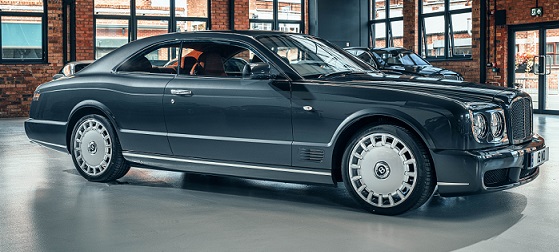

Coupe, 3 Doors, 4 Seats
19.5 l/100 km 12.06 US mpg
28.8 l/100 km 8.17 US mpg
14.1 l/100 km 16.68 US mpg
537 Hp @ 4000 rpm.
79.4 Hp/l
296 km/h 183.93 mph
6761 cm3
412.58 cu. in.
8, V-engine
Rear wheel drive,
5411 mm
213.03 in.
1932 mm
76.06 in.
2585 kg
5698.95 lbs.
| Brand | Bentley |
|---|---|
| Model | Brooklands (Coupe) |
| Version | Brooklands II |
| Engine version | 6.75 i V8 Biturbo (537 Hp) |
| Year production start | 2008 |
| Year production end | 2011 |
| Vehicle type | Coupe |
| Horsepower RPM | 537 Hp @ 4000 rpm. |
| Acceleration 0 - 100 kmh sec | 5.3 sec |
| Curb weight kg -lbs total |
2585 kg5698.95 lbs. |
| Overall length mm - inch |
5411 mm213.03 in. |
| Doors | 3 |
| Top Speed | 296 km/h 183.93 mph |
| Designation model | BFA |
|---|---|
| Cam configuration | OHC |
| Engine position and orientation | Front, Longitudinal |
| Cylinders | 8 |
| Position of cylinders | V-engine |
| Displacement (liters) |
6761 cm3412.58 cu. in. |
| Eng. horsepower RPM | 537 Hp @ 4000 rpm. |
| Horsepower per litre | 79.4 Hp/l |
| Weight / horsepower kg/hp - hp/tons |
4.8 kg/Hp207.7 Hp/tonne |
| Weight / torque kg/Nm - Nm/tons | 2.5 kg/Nm, 406.2 Nm/tonne
2.5 kg/Nm406.2 Nm/tonne |
| Torque Nm RPM lb-ft RPM |
1050 Nm @ 3250 rpm.774.44 lb.-ft. @ 3250 rpm. |
| Fuel delivery system | Multi-point indirect injection |
| Fuel type | Petrol (Gasoline) |
| Valvetrain | 4 |
| Engine aspiration | Turbocharger, Intercooler |
| Engine oil liters | quarts |
9 l9.51 US qt | 7.92 UK qt |
| Engine coolant |
20 l21.13 US qt | 17.6 UK qt |
| Emission certification | Euro 4 |
| Powertrain architecture | Internal Combustion engine |
| Engine location | Front, Longitudinal |
| Drive configuration | Rear wheel drive |
|---|
| Front brakes | Ventilated discs |
|---|---|
| Rear brakes | Ventilated discs |
| Brake control | Disc |
| Anti-lock brake system | ABS (Anti-lock braking system) |
| Passengers seats | 4 |
|---|
| Overall length mm - inch |
5411 mm213.03 in. |
|---|---|
| Overall width mm -inch |
1932 mm76.06 in. |
| Overall height mm -inch |
1437 mm56.57 in. |
| Wheelbase mm - inch |
3116 mm122.68 in. |
| Track width front mm - inch |
1610 mm63.39 in. |
| Track width rear mm - inch |
1580 mm62.2 in. |
| Curb weight kg -lbs total |
2585 kg5698.95 lbs. |
|---|---|
| Gross weight kg -lbs total |
3165 kg6977.63 lbs. |
| Capacities kg - lbs |
580 kg1278.68 lbs. |
| Fuel tank liters | gallons |
96 l25.36 US gal | 21.12 UK gal |
| City l/100km - mpg |
28.8 l/100 km8.17 US mpg |
|---|---|
| Highway l/100 km - mpg |
14.1 l/100 km16.68 US mpg |
| Combined l/100 km - Mpg |
19.5 l/100 km12.06 US mpg |
| Autonomy km (combined use) | 505 |
8 CYLINDER V-Engine
https://www.thecarspec.net/components/engine/8-cylinders-v